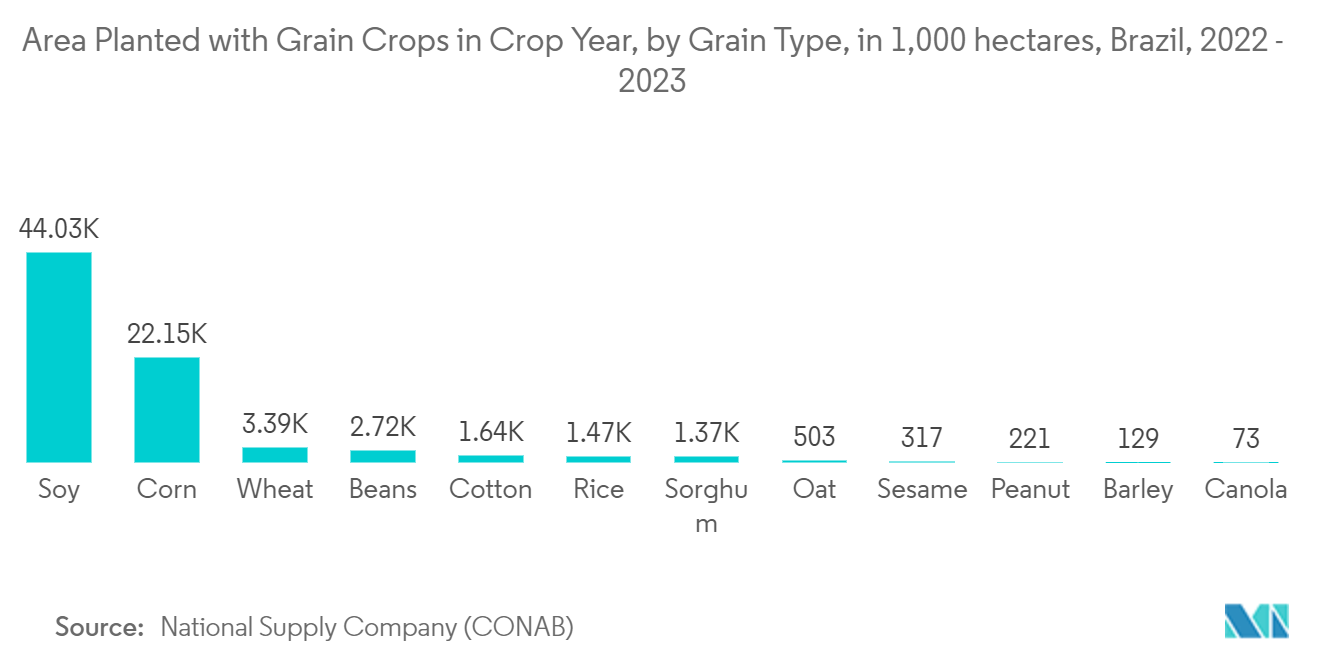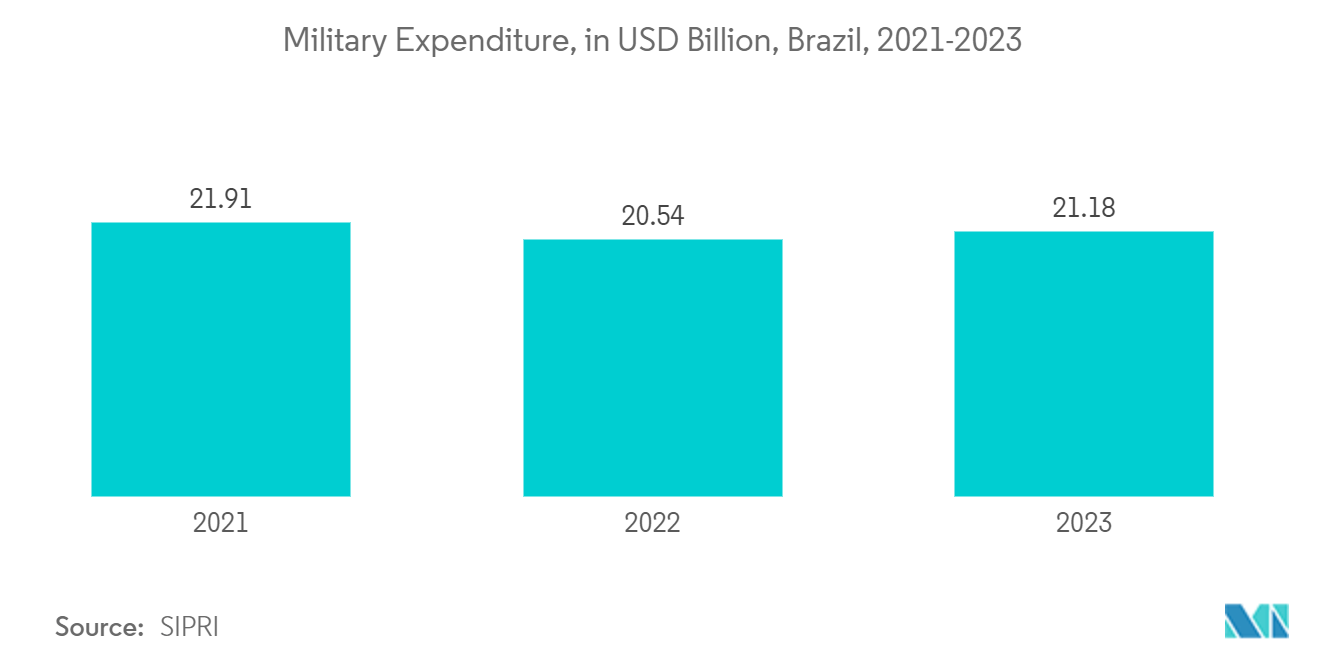Market Trends of Brazil Satellite Imagery Services Industry
Natural Resource Management is Expected to Significant Share
- The technology is being used for monitoring natural resources, such as vegetation, geological and soil analysis, land surface climatology, hydrology, and land cover change, and the generation of orthorectified digital elevation models (DEMs).
- According to the International Monetary Fund (IMF), brazil's population in 2023 is 215.16 million inhabitants. This expulsion is increasing the need for higher agricultural production and reliable crop status information. To achieve this, governments and other agricultural organizations are aiming to improve agricultural resources, especially in developing countries.
- Satellite imaging is helping farmers conduct crop forecasting and manage their agriculture production by utilizing multispectral imagery. The data generated by these methods is then used in GIS management systems to analyze and visualize agricultural environments and workflows. However, free tools, like Google Earth Pro, are helping regional farmers identify areas in fields requiring a closer analysis to decide if additional irrigation or fertilization of the crop is required.
- However, for large areas with pan-sharped vegetation indices, resolutions of 30 cm, 40 cm, or 50 cm are required. Thus, the satellite is expected to use these high- and medium-resolution satellite images, particularly for precision agriculture, with minimum commitments of 50-100 km² per area. Major applications within this segment are assessing deforestation and managing coastal lines, driven by commercial logging, forest farming, fuelwood gathering, agriculture, and pasture clearance. Furthermore, changing conditions due to urban sprawl, as well as increasing forest fragmentation, led to an increasing focus on forest productivity, reforestation, forest health, conservation of soil, water resources, and nutrient cycling.
- Satellite imaging and geographic information systems (GIS) maps can be useful for assessing and analyzing natural resources such as agriculture, forestry, and coastal management. For better study, assessment, and monitoring of natural resources, satellite imagery with spatial resolutions of up to 30 cm can be used. This technique can help with vegetation and ecosystem dynamics, hazard and disaster monitoring, geology and soil studies, land surface climatology, hydrology, land cover change, and the development of orthorectified digital elevation models (DEMs), all of which are relevant to global change.
- As per the National Supply Company (CONAB), Soybean is by far the most important grain crop in Brazil, based on planted area. During crop year 2022/2023, it was estimated that nearly 44 million hectares in the country were produced with this oilseed. The crop also accounted for almost half of the agricultural production value in Brazil in 2021. The area planted with grain crops in Brazil was forecast at around 78 million hectares in the 2022/2023 crop year. Image data is collected and translated into management systems for crop health and better production targets using high-resolution, multispectral satellite or aerial photography and artificial intelligence (AI), machine learning (ML), and computer vision (CV) algorithms.

Military and Defense is Expected to Hold Significant Share
- The satellite industry is still active in Latin America, a continent with enormous swaths of unconnected land. Many governments have invested in developing nanosatellites for scientific reasons and satellites for communication, imagery and climate monitoring. Although there is already growing in the region, most projects, including manufacturing, are carried out in collaboration with - and occasionally with funding from - other governments and foreign firms. On the other hand, brazil has yet to perfect the launch technology.
- Earth observation using high-resolution satellite imagery has long been a source of information for significant and urgent national security and defense concerns. Earth observation technologies are beneficial for monitoring land and sea borders in remote and isolated areas. It is possible to analyze vast sets of historical data and devise procedures to avoid border infractions at the regional and national levels using high-resolution satellite photos, aerial photography, and drones. Furthermore, technologies can be utilized to monitor large geographical areas and offer up-to-date information regarding infrastructure, logistics, and military installations in local conflicts. It's beneficial for assessing damage quickly in local conflict zones.
- With rising marine traffic, border security enforcement, and an increase in illicit activities and hazards at sea, it is more critical than ever to be able to properly monitor, respond, and defend our oceans and waterways. Pleiades Neo provides law enforcement agencies with a new level of maritime intelligence. The governement can now provide immediate insight for effective surveillance thanks to its 30cm resolution comprehensive imagery and multi-visit capabilities. Pleiades Neo is useful for identifying illicit activities/routes, trafficking, oil spill monitoring, and illegal fishing in maritime security and environmental applications.
- Brazil has recently launched a nanosatellite produced domestically and will be used to observe space and the atmosphere. NanoSatC-Br2 was launched into orbit on Russia's Soyuz-2 , following a postponement due to technical concerns. The satellite is now in low earth orbit (LEO). It will investigate and monitor the magnetosphere, geomagnetic field intensity, and energetic particle precipitation over Brazilian territory in real-time, among other things.Brazil is also developing its feet in Earth observation satellite systems. The country's latest observation satellite, Amazônia-1, was launched from an Indian base.
- According to SIPRI, In 2022, the government of Brazil spent more than USD 17.7 billion in the military sector. Satellite imaging allows alarm and video surveillance systems to be connected to security centers via satellite. Alarm messages and live video images can both be sent at the same time. The video images can be used for surveillance or alarm verification. Emergency voice conversations and remote control of devices such as cameras were made possible through bidirectional audio and internet-like data channels.


